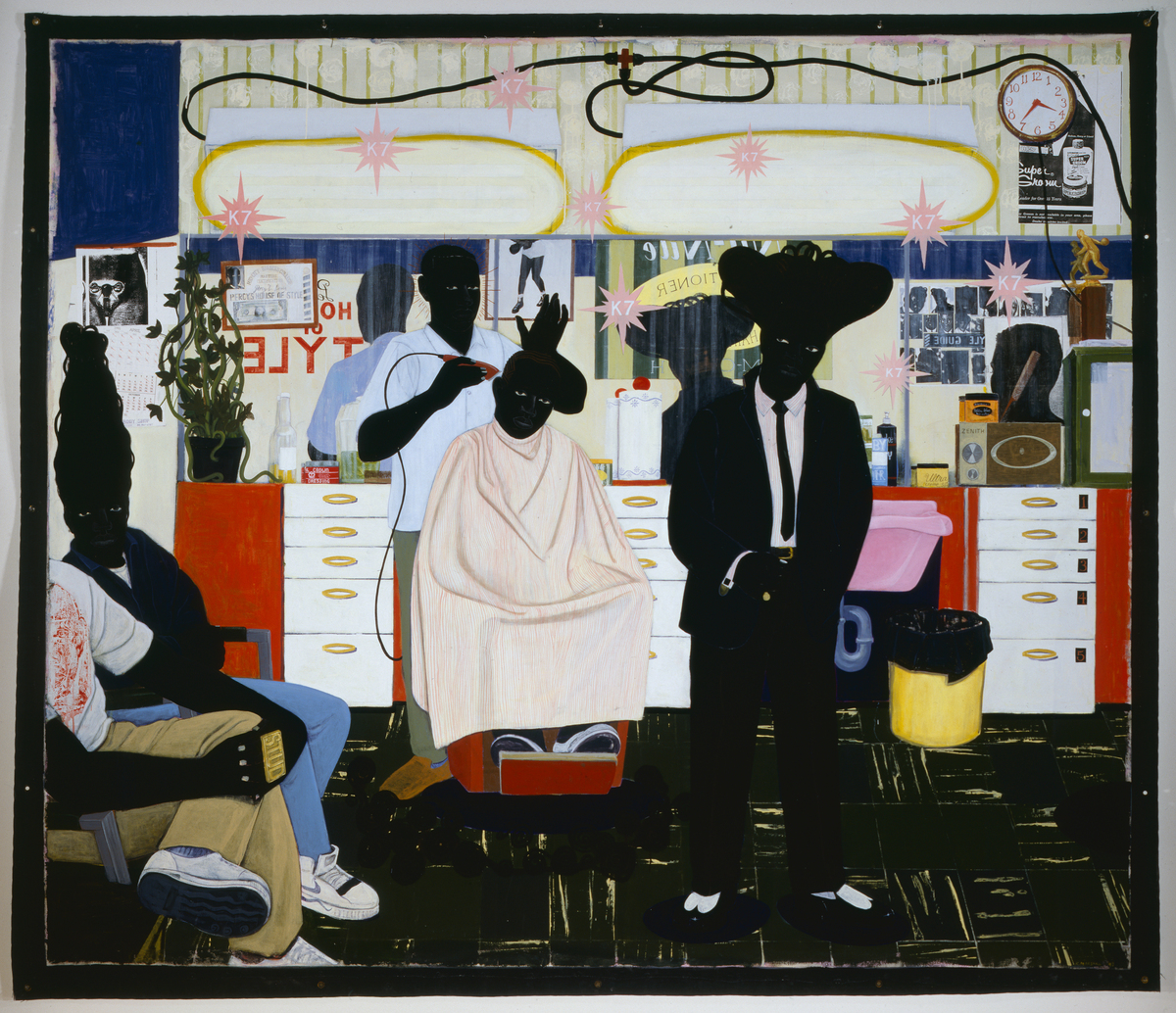Things You Know but Cannot Explain Boise Art Museum

Kerry James Marshall has spent his career depicting black lives on sail. He says inclusion in the fine art world shouldn't be contingent on "whether somebody likes y'all ... or somebody'south being generous to you lot." Above, his 2014 piece of work, Untitled (Club Couple). The Museum of Gimmicky Art hide caption
toggle caption
The Museum of Contemporary Art
With his large-scale, exuberant paintings, creative person Kerry James Marshall is on a mission: to brand the presence of blackness people and black culture in the fine art globe "indispensable" and "undeniable." Now 61, Marshall was a young artist when he decided to paint exclusively black figures.
"One of the reasons I paint black people is because I am a black person ..." he says. "In that location are fewer representations of black figures in the historical record ..."
Marshall was born in Birmingham, Ala., in 1955, only before the Montgomery Charabanc Boycott began. He grew upwardly in Southward Central, Los Angeles, and was living in the Watts neighborhood in 1965, when riots broke out in protest of police brutality.
"The hope was always to brand sure these works institute their way into museums so they could exist alongside everything else that people go into museums to look at," Marshall says.
And information technology'southward worked — a 35-yr retrospective of his work has appeared at New York'due south Metropolitan Museum of Fine art, Chicago's Museum of Contemporary Art, and at present, the Museum of Contemporary Art in Los Angeles.
His paintings depict daily life — people planting gardens, picnicking and getting haircuts. Helen Molesworth, curator of the Museum of Gimmicky Art exhibit, points out Marshall's 1993 piece of work, De Manner. "I consider this to be Kerry'due south showtime great painting," she says. It'due south a massive canvass that shows a scene in a barbershop.

De Style, acrylic and collage on sheet, 1993 LACMA, licensed by Fine art Resource, NY/Museum of Contemporary Art hide caption
toggle explanation
LACMA, licensed by Art Resource, NY/Museum of Contemporary Art

De Style, acrylic and collage on sail, 1993
LACMA, licensed past Art Resource, NY/Museum of Contemporary Art
"He'due south going to give yous an prototype of blackness, of African-American culture, of daily life that is both rooted in everyday pleasures, just besides transcendent at the same time," Molesworth says.
Molesworth'due south favorite painting, School of Beauty, School of Civilisation is awe-inspiring. Information technology bursts with riotous colors and spirited life. The work shows women's space — little kids play equally ladies pose and primp.

Kerry James Marshall, School of Beauty, School of Culture, acrylic and glitter on unstretched canvas, 2012 Sean Pathasema/The Museum of Contemporary Art hide caption
toggle caption
Sean Pathasema/The Museum of Contemporary Art

Kerry James Marshall, School of Dazzler, School of Culture, acrylic and glitter on unstretched canvas, 2012
Sean Pathasema/The Museum of Contemporary Art
"One of the things that these pictures show us over and over once again is that the category of beauty is actually large," Molesworth says. "If whiteness is the just form of beauty you see, y'all are operating in a pretty minor universe."
People can get emotional in front of these paintings.
"I've seen people kiss in front of Kerry James Marshall paintings ..." Molesworth says. "These paintings are emotional — they are filled with honey."
It's not all happiness on these walls, though — there are funerals, killers, lost boys, acrimony and grief — but ever depicted in vivid, bold colors and powerful shapes.
Marshall'due south 1994 "Garden Project" series shows the early, utopian days of public housing in Chicago and Los Angeles. Lovers stroll along groomed lawns, men rake and plant flowers, children ride bikes and run dogs.

Marshall'south 1994 "Garden Project" series shows the early, utopian days of public housing in Chicago and Los Angeles. Brian Forrest/Museum of Contemporary Art hide explanation
toggle caption
Brian Forrest/Museum of Contemporary Art

Marshall's 1994 "Garden Project" series shows the early, utopian days of public housing in Chicago and Los Angeles.
Brian Forrest/Museum of Contemporary Art
"At that place's kind of a mixed message and it has everything to do with what people expect in a painting that's about housing projects," Marshall says.
In one, a man sits on 1 hip, leaning frontward on the grass, supported past extended arms. He stares directly at us — very seriously. Behind him, white pigment blots a big sign that says Welcome to Altgeld Gardens. Click here to get a closer look at the painting. Some might perceive desperation in his optics — but non the creative person.
"I know meliorate," says Marshall, who has lived in public housing. "I know it's not so despairing. ... When I look at his demeanor, I run across contentment. That's what I see. The gaze out at the spectator, there's a certain dubiety well-nigh the way he sees himself being perceived by the spectator."
These are not romanticized images; they are brilliant, energetic, real-life reports — and Marshall wants those reports on museums walls. His works have sold at auction for $i meg and $two million. And his paintings are part of the permanent collections of the Met, the National Gallery, the Museum of Fine Arts Boston and more.
"What you're trying to create is a sure kind of an indispensable presence," Marshall says. "Where your position in the narrative is non contingent on whether somebody likes you, or somebody knows y'all, or somebody's a friend, or somebody'southward beingness generous to you lot. But y'all want a presence in the narrative that'south non negotiable, that'south undeniable."
Source: https://www.npr.org/2017/03/28/521683667/kerry-james-marshall-a-black-presence-in-the-art-world-is-not-negotiable
0 Response to "Things You Know but Cannot Explain Boise Art Museum"
Post a Comment